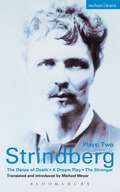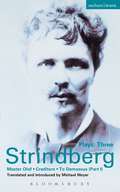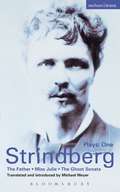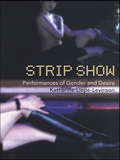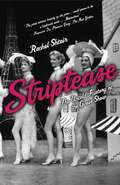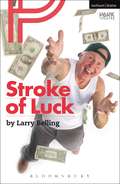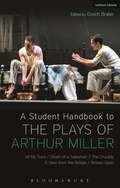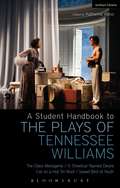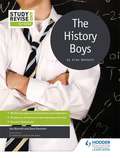- Table View
- List View
Strindberg Plays: Dream Play; Dance of Death; The Stronger
by August StrindbergThe second volume in the series of authoritative Methuen editions of Strindberg's Collected PlaysThis volume contains two of Strindberg's best-known plays from the years following his mental breakdown: the expressionist masterpiece A Dream Play (1901), which he described as 'my most beloved play, child of my greatest pain'; and both parts of The Dance of Death (1900), a terrifying analysis of a tormented marriage: 'it leaves an astonishing, an almost unaccountable, impression of genius ... as a beggar's cloak full of holes may have a kind of majestic beauty when the wind fills it, so this broken drama, having unmistakably the winds of vision in it, has beauty and dignity and power' (The Times, 1928). Also included is his earlier short play The Stronger (1889), a fascinating study of the power of personality."Michael Meyer is the translator most actors turn to when seeking a definitive text" (Sunday Times)
Strindberg Plays: Master Olof; Creditors; To Damascus (Penguin Classics)
by August StrindbergThe third volume in the series of authoritative Methuen editions of Strindberg's Collected PlaysThis volume brings together Strindberg's first great play, Master Olof (1872): 'Michael Meyer's agile translation of a flawed idealist who shrinks from the logic of his own actions and puts compromise before martyrdom' (Guardian); Creditors (1888), portraying a marriage chillingly close to his own: 'one of the finest of his plays ... holds one in its icy grip' (Sunday Telegraph); and To Damascus (Part I) (1898), 'a play so packed with ideas and invective that it makes most contemporary dramas seem trivial' (Scotsman)."Michael Meyer is the translator most actors turn to when seeking a definitive text" (Sunday Times)
Strindberg Plays: The Father; Miss Julie; The Ghost Sonata
by August Strindberg Michael MeyerThis volume contains three of Strindberg's most famous plays, spanning twenty years of prodigious creativity and recurrent personal crises: The Father, which displays Strindberg's suspicion of women at its most implacable, 'powerful and profound' (Guy de Maupassant); Miss Julie (1888), which he called his masterpiece, and in which he presents with startling modernity the conflict between sexual passion and social position; and The Ghost Sonata (1907), written in physical pain and spiritual torment, which is a phantasmagoric dream play, 'a direct source for the Theatre of the Absurd' (Martin Esslin)."Michael Meyer is the translator most actors turn to when seeking a definitive text" (Sunday Times)
Strindberg Plays: Dream Play; Dance of Death; The Stronger
by August Strindberg Michael MeyerThe second volume in the series of authoritative Methuen editions of Strindberg's Collected PlaysThis volume contains two of Strindberg's best-known plays from the years following his mental breakdown: the expressionist masterpiece A Dream Play (1901), which he described as 'my most beloved play, child of my greatest pain'; and both parts of The Dance of Death (1900), a terrifying analysis of a tormented marriage: 'it leaves an astonishing, an almost unaccountable, impression of genius ... as a beggar's cloak full of holes may have a kind of majestic beauty when the wind fills it, so this broken drama, having unmistakably the winds of vision in it, has beauty and dignity and power' (The Times, 1928). Also included is his earlier short play The Stronger (1889), a fascinating study of the power of personality."Michael Meyer is the translator most actors turn to when seeking a definitive text" (Sunday Times)
Strindberg Plays: Master Olof; Creditors; To Damascus
by August Strindberg Michael MeyerThe third volume in the series of authoritative Methuen editions of Strindberg's Collected PlaysThis volume brings together Strindberg's first great play, Master Olof (1872): 'Michael Meyer's agile translation of a flawed idealist who shrinks from the logic of his own actions and puts compromise before martyrdom' (Guardian); Creditors (1888), portraying a marriage chillingly close to his own: 'one of the finest of his plays ... holds one in its icy grip' (Sunday Telegraph); and To Damascus (Part I) (1898), 'a play so packed with ideas and invective that it makes most contemporary dramas seem trivial' (Scotsman)."Michael Meyer is the translator most actors turn to when seeking a definitive text" (Sunday Times)
Strip Show: Performances of Gender and Desire (Gender in Performance)
by Katherine Liepe-LevinsonThis book offers an account of an unprecedented North American study of contemporary female and male strip shows. It particularly focuses on the contradictory sex roles, cultural positions, and performance practices of 'straight' strip shows during their second heyday in the early 1990s.Katherine Liepe-Levinson's research took her to over seventy different strip bars, clubs, theatres and sex emporiums ranging from elaborate lap-dancing and couch-dancing 'gentlemen's' clubs in New York, Houston, and San Francisco; to Peoria's onetime duplex cabaret where women strip for men downstairs, and men for women upstairs; to the nightclubs of Montreal where female and male performers displayed the 'Full Monty'. Liepe-Levinson's intriguing, comprehensive study concentrates on the cultural and theatrical elements of the strip shows themselves including the geographic locations and interior designs of the clubs, the choreography and costumes of the dancers and the all-important participation of the audience. She draws upon a variety of methodologies as well as interviews with performers to explore how the strip show's cultural and theatrical aspects simultaneously uphold and break traditional sex roles. Her findings readily complicate several of the most prominent and prevalent theories about sexual representation, gender and desire.
Strip Show: Performances of Gender and Desire (Gender in Performance)
by Katherine Liepe-LevinsonThis book offers an account of an unprecedented North American study of contemporary female and male strip shows. It particularly focuses on the contradictory sex roles, cultural positions, and performance practices of 'straight' strip shows during their second heyday in the early 1990s.Katherine Liepe-Levinson's research took her to over seventy different strip bars, clubs, theatres and sex emporiums ranging from elaborate lap-dancing and couch-dancing 'gentlemen's' clubs in New York, Houston, and San Francisco; to Peoria's onetime duplex cabaret where women strip for men downstairs, and men for women upstairs; to the nightclubs of Montreal where female and male performers displayed the 'Full Monty'. Liepe-Levinson's intriguing, comprehensive study concentrates on the cultural and theatrical elements of the strip shows themselves including the geographic locations and interior designs of the clubs, the choreography and costumes of the dancers and the all-important participation of the audience. She draws upon a variety of methodologies as well as interviews with performers to explore how the strip show's cultural and theatrical aspects simultaneously uphold and break traditional sex roles. Her findings readily complicate several of the most prominent and prevalent theories about sexual representation, gender and desire.
Striptease: The Untold History of the Girlie Show
by Rachel ShteirStriptease recreates the combustible mixture of license, independence, and sexual curiosity that allowed strippers to thrive for nearly a century. Rachel Shteir brings to life striptease's Golden Age, the years between the Jazz Age and the Sexual Revolution, when strippers performed around the country, in burlesque theatres, nightclubs, vaudeville houses, carnivals, fairs, and even in glorious palaces on the Great White Way. Taking us behind the scenes, Shteir introduces us to a diverse cast of characters that collided on the burlesque stage, from tight-laced political reformers and flamboyant impresarios, to drag queens, shimmy girls, cootch dancers, tit serenaders, and even girls next door, lured into the profession by big-city aspirations. Throughout the book, readers will find essential profiles of famed performers, including Gypsy Rose Lee, "the Literary Stripper"; Lili St. Cyr, the 1950s mistress of exotic striptease; and Blaze Starr, the "human heat wave," who literally set the stage on fire. Striptease is an insightful and entertaining portrait of an art form at once reviled and embraced by the American public. Blending careful research and vivid narration, Rachel Shteir captures striptease's combination of sham and seduction while illuminating its surprisingly persistent hold on the American imagination.
Stroke of Luck (Modern Plays)
by Larry BellingShortly after the death of his wife, Lester Riley, an invalid who has suffered a premature stroke, announces to his three estranged middle-aged children that he is getting married again – to his young, sexy Japanese nurse. His children are also shocked to learn that Lester has saved an enormous amount of money from his secret life as the exclusive television and radio repairman to a Long Island Mafia family. To stop the nurse from getting this surprise inheritance they must stop the marriage. They try every trick in the book: legal, religious, psychological and – in the case of one son – criminal. But they fail; or do they? Lester, it seems, has a few tricks up his own sleeve.Stroke of Luck is a dark comedy that explores the themes of greed and guilt, how to reunite families that have been driven apart, and how debilitating physical ailments do not necessarily mean diminished mental faculties.
Stroke of Luck (Modern Plays)
by Larry BellingShortly after the death of his wife, Lester Riley, an invalid who has suffered a premature stroke, announces to his three estranged middle-aged children that he is getting married again – to his young, sexy Japanese nurse. His children are also shocked to learn that Lester has saved an enormous amount of money from his secret life as the exclusive television and radio repairman to a Long Island Mafia family. To stop the nurse from getting this surprise inheritance they must stop the marriage. They try every trick in the book: legal, religious, psychological and – in the case of one son – criminal. But they fail; or do they? Lester, it seems, has a few tricks up his own sleeve.Stroke of Luck is a dark comedy that explores the themes of greed and guilt, how to reunite families that have been driven apart, and how debilitating physical ailments do not necessarily mean diminished mental faculties.
Structural Design for the Stage
by Alys Holden Bronislaw Sammler Bradley L Powers Steven A SchmidtThe follow-up to the 2000 Golden Pen Award-winning Structural Design for the Stage, this second edition provides the theater technician with a foundation in structural design, allowing an intuitive understanding of "why sets stand up." It introduces the basics of statics and the study of the strength of materials as they apply to typical scenery, emphasizing conservative approaches to real world examples. This is an invaluable reference for any serious theatre technician throughout their career, from the initial study of the fundamental concepts, to the day-to-day use of the techniques and reference materials. Now in hardcover, with nearly 200 new pages of content, it has been completely revised and updated to reflect the latest recommended practices of the lumber and steel industries, while also including aluminum design for the first time.
Structural Design for the Stage
by Alys Holden Bronislaw Sammler Bradley L Powers Steven A SchmidtThe follow-up to the 2000 Golden Pen Award-winning Structural Design for the Stage, this second edition provides the theater technician with a foundation in structural design, allowing an intuitive understanding of "why sets stand up." It introduces the basics of statics and the study of the strength of materials as they apply to typical scenery, emphasizing conservative approaches to real world examples. This is an invaluable reference for any serious theatre technician throughout their career, from the initial study of the fundamental concepts, to the day-to-day use of the techniques and reference materials. Now in hardcover, with nearly 200 new pages of content, it has been completely revised and updated to reflect the latest recommended practices of the lumber and steel industries, while also including aluminum design for the first time.
Stuart Academic Drama: An Edition of Three University Plays (Routledge Library Editions: Renaissance Drama)
by David L. RussellAlthough not much is known about the three Stuart plays in this edition, which was first published in 1987, we can ascribe them to one of the English universities, and each is indicative of a distinctly different influence on the Renaissance academic drama. Heteroclitanomalonomia is part of a minor subgenre referred to as the academic play. It demonstrates the predominance of language or rhetoric studies in the period and its very subject is of purely academic interest. Gigantomachia displays the continuing interest of the Renaissance in classical mythology. And A Christmas Messe follows a more homely tradition, a farcical personification of the mundane. This title will be of interest to students of English Literature, Drama and Performance.
Stuart Academic Drama: An Edition of Three University Plays (Routledge Library Editions: Renaissance Drama)
by David L. RussellAlthough not much is known about the three Stuart plays in this edition, which was first published in 1987, we can ascribe them to one of the English universities, and each is indicative of a distinctly different influence on the Renaissance academic drama. Heteroclitanomalonomia is part of a minor subgenre referred to as the academic play. It demonstrates the predominance of language or rhetoric studies in the period and its very subject is of purely academic interest. Gigantomachia displays the continuing interest of the Renaissance in classical mythology. And A Christmas Messe follows a more homely tradition, a farcical personification of the mundane. This title will be of interest to students of English Literature, Drama and Performance.
Stuart Women Playwrights, 1613–1713
by Pilar Cuder-DominguezIn the field of seventeenth-century English drama, women participated not only as spectators or readers, but more and more as patronesses, as playwrights, and later on as actresses and even as managers. This study examines English women writers' tragedies and tragicomedies in the seventeenth century, specifically between 1613 and 1713, which represent the publication dates of the first original tragedy (Elizabeth Cary's The Tragedy of Mariam) and the last one (Anne Finch's Aristomenes) written by a Stuart woman playwright. Through this one-hundred year period, major changes in dramatic form and ideology are traced in women's tragedies and tragicomedies. In examining the whole of the century from a gender perspective, this project breaks away from conventional approaches to the subject, which tend to establish an unbridgeable gap between the early Stuart period and the Restoration. All in all, this study represents a major overhaul of current theories of the evolution of English drama as well as offering an unprecedented reconstruction of the genealogy of seventeenth-century English women playwrights.
Stuart Women Playwrights, 1613–1713
by Pilar Cuder-DominguezIn the field of seventeenth-century English drama, women participated not only as spectators or readers, but more and more as patronesses, as playwrights, and later on as actresses and even as managers. This study examines English women writers' tragedies and tragicomedies in the seventeenth century, specifically between 1613 and 1713, which represent the publication dates of the first original tragedy (Elizabeth Cary's The Tragedy of Mariam) and the last one (Anne Finch's Aristomenes) written by a Stuart woman playwright. Through this one-hundred year period, major changes in dramatic form and ideology are traced in women's tragedies and tragicomedies. In examining the whole of the century from a gender perspective, this project breaks away from conventional approaches to the subject, which tend to establish an unbridgeable gap between the early Stuart period and the Restoration. All in all, this study represents a major overhaul of current theories of the evolution of English drama as well as offering an unprecedented reconstruction of the genealogy of seventeenth-century English women playwrights.
Student Companion to Eugene O'Neill (Student Companions to Classic Writers)
by Steven F. Ph.D.Eugene O'Neill is the only American dramatist ever to have received the Nobel Prize for Literature. He wrote over 50 plays; a number are virtually unknown by the general public; several are considered classics of the American stage; all of them demonstrate, in one way or another, how O'Neill challenged the conventional boundaries of the drama of his time and thereby paved the way for modern American theatre. This volume will provide guides to eight of O'Neill's plays that are most often studied in schools and colleges: The Hairy Ape, Anna Christie, The Emperor Jones, Desire Under the Elms, Ah, Wilderness!, The Iceman Cometh, Long Day's Journey Into Night, and A Moon for the Misbegotten. More than almost any other author in any fictional genre, O'Neill's works are highly autobiographical. The love/hate relationships he had with the members of his own family resonate throughout his dramatic works. The son of an alcoholic and a morphine addict, he struggled with chemical dependency throughout his life, but determined to be an artist or nothing, he eventually gave up drinking and fulfilled his artistic ambitions, transforming the traumatic experiences of his life into compelling drama. O'Neill's drama provides insights into the complexities of human behavior and raises questions about the forces, both external and internal, that shape human lives.
A Student Handbook to the Plays of Arthur Miller: All My Sons, Death of a Salesman, The Crucible, A View from the Bridge, Broken Glass
by Alan Ackerman Susan C. Abbotson Stephen Marino Toby Zinman Enoch BraterA Student Handbook to the Plays of Arthur Miller provides the essential guide to Miller's most studied and revived dramas. Authored by a team of leading scholars, it offers students a clear analysis and detailed commentary on five of Miller's plays: All My Sons, Death of a Salesman, The Crucible, A View from the Bridge and Broken Glass. A consistent framework of analysis ensures that whether readers want a summary of the play, a commentary on the themes or characters, or a discussion of the work in performance, they can readily find what they need to develop their understanding and aid their appreciation of Miller's artistry. A chronology of Miller's life and work helps to situate his oeuvre in context and the introduction reinforces this by providing a clear overview of his writing, its recurrent themes and how these are intertwined with his life and times. For each play the author provides a summary of the plot, followed by commentary on the context, themes, characters, structure and language, and the play in production - both on stage and screen adaptations; there are questions for further study and detailed notes on words and phrases in the text. The wealth of authoritative and clear commentary on each play, together with further questions that encourage comparison across Miller's work and related plays by other leading writers, ensures that this is the clearest and fullest guide to Miller's greatest plays.
A Student Handbook to the Plays of Arthur Miller: All My Sons, Death of a Salesman, The Crucible, A View from the Bridge, Broken Glass
by Alan Ackerman Susan C. Abbotson Stephen Marino Toby Zinman Enoch BraterA Student Handbook to the Plays of Arthur Miller provides the essential guide to Miller's most studied and revived dramas. Authored by a team of leading scholars, it offers students a clear analysis and detailed commentary on five of Miller's plays: All My Sons, Death of a Salesman, The Crucible, A View from the Bridge and Broken Glass. A consistent framework of analysis ensures that whether readers want a summary of the play, a commentary on the themes or characters, or a discussion of the work in performance, they can readily find what they need to develop their understanding and aid their appreciation of Miller's artistry. A chronology of Miller's life and work helps to situate his oeuvre in context and the introduction reinforces this by providing a clear overview of his writing, its recurrent themes and how these are intertwined with his life and times. For each play the author provides a summary of the plot, followed by commentary on the context, themes, characters, structure and language, and the play in production - both on stage and screen adaptations; there are questions for further study and detailed notes on words and phrases in the text. The wealth of authoritative and clear commentary on each play, together with further questions that encourage comparison across Miller's work and related plays by other leading writers, ensures that this is the clearest and fullest guide to Miller's greatest plays.
A Student Handbook to the Plays of Tennessee Williams: The Glass Menagerie; A Streetcar Named Desire; Cat on a Hot Tin Roof; Sweet Bird of Youth
by Stephen Bottoms Philip Kolin Michael Hooper Katherine WeissA Student Handbook to the Plays of Tennessee Williams provides the essential guide to Williams' most studied and revived dramas. Authored by a team of leading scholars, it offers students a clear analysis and detailed commentary on four of Williams' plays: The Glass Menagerie, A Streetcar Named Desire, Cat on a Hot Tin Roof and Sweet Bird of Youth. A consistent framework of analysis ensures that whether readers are wanting a summary of the play, a commentary on the themes or characters, or a discussion of the work in performance, they can readily find what they need to develop their understanding and aid their appreciation of Williams' artistry.A chronology of the writer's life and work helps to situate all his works in context and the introduction reinforces this by providing a clear overview of Williams' writing, its recurrent themes and concerns and how these are intertwined with his life and times. For each play the author provides a summary of the plot, followed by commentary on:* The context* Themes* Characters* Structure and language* The play in production (both on stage and screen adaptations)Questions for study, and notes on words and phrases in the text are also supplied to aid the reader.The wealth of authoritative and clear commentary on each play, together with further questions that encourage comparison across Williams' work and related plays by other leading writers, ensures that this is the clearest and fullest guide to Williams' greatest plays.
A Student Handbook to the Plays of Tennessee Williams: The Glass Menagerie; A Streetcar Named Desire; Cat on a Hot Tin Roof; Sweet Bird of Youth
by Stephen Bottoms Philip Kolin Michael Hooper Katherine WeissA Student Handbook to the Plays of Tennessee Williams provides the essential guide to Williams' most studied and revived dramas. Authored by a team of leading scholars, it offers students a clear analysis and detailed commentary on four of Williams' plays: The Glass Menagerie, A Streetcar Named Desire, Cat on a Hot Tin Roof and Sweet Bird of Youth. A consistent framework of analysis ensures that whether readers are wanting a summary of the play, a commentary on the themes or characters, or a discussion of the work in performance, they can readily find what they need to develop their understanding and aid their appreciation of Williams' artistry.A chronology of the writer's life and work helps to situate all his works in context and the introduction reinforces this by providing a clear overview of Williams' writing, its recurrent themes and concerns and how these are intertwined with his life and times. For each play the author provides a summary of the plot, followed by commentary on:* The context* Themes* Characters* Structure and language* The play in production (both on stage and screen adaptations)Questions for study, and notes on words and phrases in the text are also supplied to aid the reader.The wealth of authoritative and clear commentary on each play, together with further questions that encourage comparison across Williams' work and related plays by other leading writers, ensures that this is the clearest and fullest guide to Williams' greatest plays.
Study and Revise: A Streetcar Named Desire for AS/A-level (PDF)
by Nicola OnyettEnable students to achieve their best grade in AS/A-level English Literature with this year-round course companion; designed to instil in-depth textual understanding as students read, analyse and revise A Streetcar Named Desire throughout the course. This Study and Revise guide: - Increases students' knowledge of A Streetcar Named Desire as they progress through the detailed commentary and contextual information written by experienced teachers and examiners - Develops understanding of characterisation, themes, form, structure and language, equipping students with a rich bank of textual examples to enhance their coursework and exam responses - Builds critical and analytical skills through challenging, thought-provoking questions and tasks that encourage students to form their own personal responses to the text - Extends learning and prepares students for higher-level study by introducing critical viewpoints, comparative references to other literary works and suggestions for independent research - Helps students maximise their exam potential using clear explanations of the Assessment Objectives, sample student answers and examiner insights - Improves students' extended writing techniques through targeted advice on planning and structuring a successful essay
Study and Revise: Romeo and Juliet for GCSE (PDF)
by Jane SheldonExam Board: AQA, OCR, Edexcel, WJEC Eduqas Level: GCSE (9-1) Subject: English literature First teaching: September 2015 First exams: Summer 2017 Enable students to achieve their best grade in GCSE English Literature with this year-round course companion; designed to instil in-depth textual understanding as students read, analyse and revise Romeo and Juliet throughout the course. This Study and Revise guide: - Increases students' knowledge of Romeo and Juliet as they progress through the detailed commentary and contextual information written by experienced teachers and examiners - Develops understanding of plot, characterisation, themes and language, equipping students with a rich bank of textual examples to enhance their exam responses - Builds critical and analytical skills through challenging, thought-provoking questions that encourage students to form their own personal responses to the text - Helps students maximise their exam potential using clear explanations of the Assessment Objectives, annotated sample student answers and tips for reaching the next grade - Improves students' extended writing techniques through targeted advice on planning and structuring a successful essay - Provides opportunities for students to review their learning and identify their revision needs with knowledge-based questions at the end of each chapter
Study and Revise for GCSE: The History Boys For Gcse
by Sue Bennett Dave StockwinExam Board: AQA, WJEC, WJEC EduqasLevel: GCSE (9-1)Subject: English literatureFirst teaching: September 2015First exams: Summer 2017Enable students to achieve their best grade in GCSE English Literature with this year-round course companion; designed to instil in-depth textual understanding as students read, analyse and revise The History Boys throughout the course.This Study and Revise guide:- Increases students' knowledge of The History Boys as they progress through the detailed commentary and contextual information written by experienced teachers and examiners- Develops understanding of plot, characterisation, themes and language, equipping students with a rich bank of textual examples to enhance their exam responses- Builds critical and analytical skills through challenging, thought-provoking questions that encourage students to form their own personal responses to the text- Helps students maximise their exam potential using clear explanations of the Assessment Objectives, annotated sample student answers and tips for reaching the next grade- Improves students' extended writing techniques through targeted advice on planning and structuring a successful essay- Provides opportunities for students to review their learning and identify their revision needs with knowledge-based questions at the end of each chapter
Studying Disability Arts and Culture: An Introduction
by Petra KuppersIn this accessible introduction to the study of Disability Arts and Culture, Petra Kuppers foregrounds themes, artists and theoretical concepts in this diverse field. Complete with case studies, exercises and questions for further study, the book introduces students to the work of disabled artists and their allies, and explores artful responses to living with physical, cognitive, emotional or sensory difference. Engaging readers as cultural producers, Kuppers provides useful frameworks for critical analysis and encourages students to explore their own positioning within the frames of gender, race, sexuality, class and disability. Comprehensive and accessible, this is an essential handbook for undergraduate students or anyone interested in disabled bodies and minds in theatre, performance, creative writing, art and dance.
